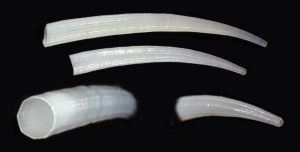Family Dentaliidae
Shell size to 25 mm (usually under 20 mm); shell tubular, dull, chalky, or glossy. Six ribs evenly spaced, but with occasional seventh rib randomly placed. There is variation in relative width of intercostal (between ribs) spaces; with small longitudinal riblets usually present. Apex (narrow end) hexagonal in cross-section. Aperture hexagonal in immature specimens, and hexagonal to circular in adult specimens. Curvature variable, but not extremely pronounced. Most abundant tusk shell species found on Sanibel. Color white. The illustration shows an adult shell on top, its aperture on left and apex on right. Center image is of a juvenile shell, its aperture below. (Entry prepared in cooperation with Rebecca Mensch.)
Read MoreShell size to 36 mm; shell tubular, glossy, devoid of ribs or major sculptural features. Apex (often missing) with about 20 very fine longitudinal lines and apical notch; supplementary tube (see inset figures on center and lower right) sometimes present, mostly in younger individuals. Curvature variable, but never extremely pronounced. Color ivory-white, apex sometimes salmon color. Not uncommon on Sanibel. (Entry prepared in cooperation with Rebecca Mensch.)
Read MoreShell size to 24 mm; shell tubular, dull. Nine ribs evenly spaced. Intercostal spaces smooth. Shell slightly curved. Concentric undulating growth lines showing at irregular intervals. Aperture and apex circular. A deeper-water species, it is one of the less common tusk shells found on Sanibel/Captiva. (Entry prepared in cooperation with Rebecca Mensch.)
Read MoreShell size to 26 mm; shell tubular, dull, chalky, or glossy. Nine evenly spaced ribs present, very rarely with an unevenly spaced tenth rib. Secondary ribs present, but not extending to apex (narrower end). Shell slightly curved. Compare with locally found Paradentalium americanum, which has six ribs instead of nine. Frequently found on Sanibel. (Entry prepared in cooperation with Rebecca Mensch.)
Read MoreShell size to 13 mm; shell tubular, dull, chalky, or glossy. The shell starts out with nine primary ribs at the apex, but as it grows, three secondary ribs rapidly appear, for a total of 12 ribs. When the apex is broken off, leaving only the wider, younger parts of the shell, it is hard to tell which ribs are primary and which are secondary. Rib shape variable, ribs covered with fine longitudinal lines. Wide apical notch on convex or concave side sometimes present. Typically with grooves between ribs presenting regularly spaced "windows" of thinner shell material. Curvature not extremely pronounced. Color white, sometimes with a greenish tint. One shell found in December 2016 at Turner Beach, Captiva, by Susan J. Hewitt. (Entry prepared in cooperation with Rebecca Mensch.)
Read More



